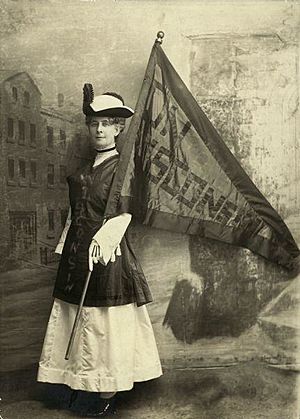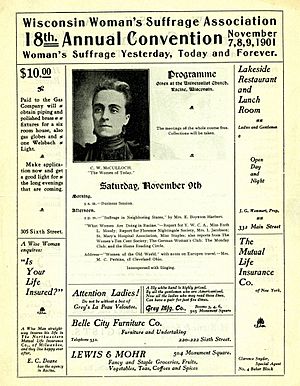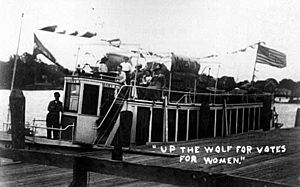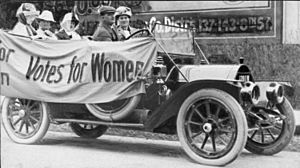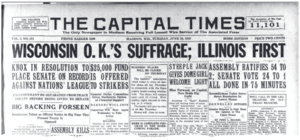Timeline of women's suffrage in Wisconsin facts for kids
This is a timeline showing when women in Wisconsin fought for the right to vote. The fight for women's suffrage, which means the right to vote, started even before the American Civil War. In 1846, when Wisconsin was creating its first state constitution, people talked about letting both women and African Americans vote. However, a more traditional constitution was chosen instead.
In the 1850s, a German-language newspaper for women's rights began in Milwaukee. Many people who supported women's voting rights spoke across the state. The first big meeting for women's suffrage in Wisconsin happened in Janesville in 1867. In the 1870s, several groups working for women's suffrage were formed.
A special law passed in 1884 allowed women to vote on school-related issues. Voters approved this law in 1886. But when women first tried to vote in 1887, there were problems. It took until 1902 for Wisconsin women to vote for school issues again, using separate ballots.
In the 1900s, women's suffrage meetings continued all over Wisconsin. Women gathered signatures and asked the state government to pass laws. In 1911, the Wisconsin legislature passed a bill for women's suffrage. This bill would be voted on by the public in 1912. But on November 4, 1912, voters said no to women's suffrage.
The fight continued! Women even started a "suffrage school." A chapter of the National Woman's Party (NWP) was formed in Wisconsin in 1915. When the Nineteenth Amendment, which gave women the right to vote across the United States, was sent to the states, Wisconsin was quick to act. Wisconsin approved it on June 10, 1919, and was the very first state to turn in its official approval papers on June 13, 1919.
The 1800s: Early Steps for Women's Votes
1840s: A New State Considers Voting Rights
1846
- October 5: People met in Madison to write the first Wisconsin Constitution. They talked about giving women and African Americans the right to vote.
- April: Voters said no to this first version of the Wisconsin Constitution.
1850s: Voices for Change Emerge
1852
- A newspaper for women's rights, Die Deutsche Frauen-Zeitung, started in Milwaukee. Mathilde Franziska Anneke founded it.
1853
- Clarina I. H. Nichols and Lydia Folger Fowler traveled through Wisconsin. They spoke about temperance (avoiding alcohol) and women's right to vote.
1855
- November: Lucy Stone spoke about women's suffrage in Madison and Kenosha.
1856
- A women's suffrage club began in Richland Center.
- Senator C. C. Sholes brought three petitions asking for women's suffrage to the state government.
1860s: Organizing for the Cause
1867
- October 9–10: The first statewide meeting for women's suffrage was held in Janesville.
1868
- The Woman Suffrage Association of Wisconsin (WSAW) was created.
1869
- February 24–25: A state suffrage meeting took place in Milwaukee. Lila Peckham and Laura Ross Wolcott helped organize it.
1870s: New Groups Form
1870
- Another state suffrage meeting was held.
1878
- The Madison Equal Suffrage Association (MESA) was founded.
1879
- The Marathon County Woman Suffrage Association was organized.
1880s: Voting for Schools and Legal Battles
1880
- May: The Mukwonago Woman Suffrage Club was started.
- A bill to allow women to vote passed in both parts of the state government. It needed to pass again the next year.
1881
- The women's suffrage bill from 1880 failed to pass the second time.
1882
- September 7: A state suffrage meeting was held in Madison. The WSAW changed its name to the Wisconsin Woman Suffrage Association (WWSA).
- Several new suffrage groups were started across the state.
1884
- A bill passed the state government. It gave women the right to vote for people running for school-related jobs.
- September: A state suffrage meeting was held in Richland Center.
1885
- A state suffrage meeting was held in Whitewater.
- The school voting bill passed again. It would now go to the voters for approval.
1886
- A state suffrage meeting was held in Racine.
- Fall: Voters approved the bill. This gave women the right to vote in elections about schools.
1887
- April: The Attorney General of Wisconsin, Charles E. Estabrook, told election workers to throw out women's votes.
- Olympia Brown was not allowed to vote in local elections.
- A state suffrage meeting was held in Madison.
- A suffrage newspaper, the Woman Citizen, began publishing.
1888
- January 31: The Wisconsin Supreme Court said that the new school voting law meant women could vote for any candidate on ballots that included school issues.
- A state suffrage meeting was held in Stevens' Point.
- The Supreme Court of the United States disagreed with the Wisconsin Court. They said women in Wisconsin could only vote on school issues, not other candidates.
1889
- Another legal case challenged the school-election law. This stopped women from voting for several years.
1890s: Keeping the Movement Alive
1890
- Theodora W. Youmans used the Waukesha Freeman newspaper to encourage women's clubs to form in Waukesha.
- A state suffrage meeting was held in Berlin.
1891
- A state suffrage meeting was held in Menominee.
1892
- A state suffrage meeting was held in Richland Center.
1893
- A state suffrage meeting was held in Mukwonago.
1894
- A state suffrage meeting was held in Racine.
1895
- A state suffrage meeting was held in Evansville.
1896
- A state suffrage meeting was held in Waukesha.
- A ten-day suffrage event was held at Manona Lake Assembly. Anna Howard Shaw spoke to about 4,000 people there.
1897
- A state suffrage meeting was held in Monroe.
1898
- A state suffrage meeting was held in Spring Green.
- A national suffrage meeting was held in Madison.
1899
- A state suffrage meeting was held in Platteville.
The 1900s: Pushing for Full Voting Rights
1900s: Renewed Efforts and Separate Ballots
1900
- A state suffrage meeting was held in Brodhead.
1901
- Belle Case La Follette worked hard to get the state government to let women vote for school-related issues again.
- Women were allowed to vote on education issues once more. This was because a law now made sure separate ballot boxes were used for school votes.
- A state women's suffrage meeting was held in Brodhead.
1902
- Offices for women's suffrage were opened in Madison.
- A state women's suffrage meeting was held in Madison.
- April 1: Women in Wisconsin voted again for school-related issues using a separate ballot.
1903
- A bill to allow women to vote in city elections was introduced. It did not get many votes.
- A bill for full women's suffrage passed in one part of the state government but not the other.
- A state women's suffrage meeting was held in Platteville.
1904
- A state women's suffrage meeting was held in Janesville.
1905
- A city suffrage bill passed in one part of the state government but failed in the other.
- A state women's suffrage meeting was held in Milwaukee.
1906
- A state women's suffrage meeting was held in Madison.
1907
- A state women's suffrage meeting was held in Madison.
1908
- A state women's suffrage meeting was held in Madison.
- Maud Wood Park visited several Wisconsin colleges. She helped start suffrage groups for college students.
1909
- A state women's suffrage meeting was held in Madison.
- The WWSA collected more than 18,000 signatures for a national women's suffrage amendment.
- A bill for a public vote on women's suffrage passed in one part of the state government but failed in the other.
1910s: The Final Push for the Vote
1910
- A state women's suffrage meeting was held in Madison.
1911
- March 31: A suffrage bill passed in one part of the state government.
- April 26: The suffrage bill passed in the other part of the state government. It would now go to the voters in 1912.
- The Political Equality League (PEL) was formed.
- The Wisconsin Men's League for Women's Suffrage was created.
- A state women's suffrage meeting was held in Racine.
- Summer: Campaign offices for the vote were set up in Milwaukee.
- August 2: A tour by car to promote women's suffrage began in Milwaukee.
1912
- November 4: The public vote on women's suffrage failed.
1913
- January: Zona Gale suggested a joint meeting of PEL and WWSA.
- February 4–5: The joint meeting was held in Madison.
- A women's suffrage bill passed in the state government but was stopped by the governor.
- PEL and WWSA combined and kept the name WWSA.
- April 26: La Follett spoke to the United States Senate Select Committee on Woman Suffrage.
1914
- June 18–24: A "suffrage school" was held in Madison to teach people about the movement.
- December: A state suffrage meeting was held.
1915
- Several bills for women's suffrage were introduced in the state government but did not pass.
1916
- March: A big meeting was held in Milwaukee with Carrie Chapman Catt as a main speaker.
- June: Suffragists from Wisconsin marched in a parade in Chicago.
1917
- A National Woman's Party chapter was started in Wisconsin.
- March 4: Olympia Brown from Wisconsin was one of the suffragists protesting outside the White House.
- A bill for a public vote was introduced but did not pass.
1919
- February: A bill allowing women to vote in Presidential elections passed.
- June 10: Wisconsin officially approved the 19th Amendment.
- June 13: Wisconsin was the first state to finish the approval process. They turned in the official papers to the Secretary of State.
1920s: The Fight Continues in a New Way
1920
- March: The WWSA group ended.
- The League of Women Voters (LWV) Wisconsin was formed. This new group continued to work for voting rights and civic education.


